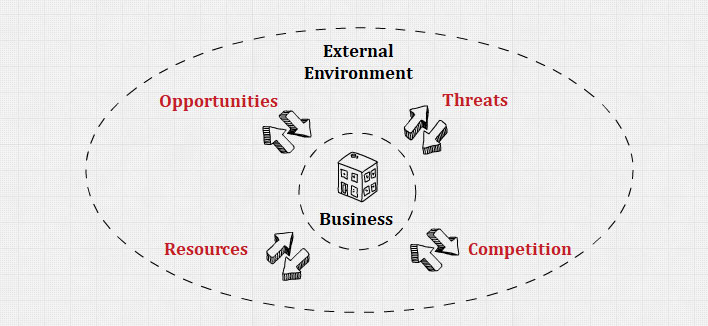What is the External Environment?

In strategy, the external environment comprises forces that exist outside the boundaries of an organization, but have potential and significant influence on its survival and growth.
Why Does the External Environment Matter?

There are 4 reasons why understanding the external environment that surrounds an organization is important to an organization.
First, the external environment provides resources that an organization needs in order to create goods and services.
As a human body must consume oxygen, food, and water, an organization needs to take in resources such as labor, money, and raw materials from outside its boundaries. An organization cannot survive without the support of its environment.
Second, the external environment is a source of opportunities and threats for an organization.
Opportunities are events and trends that create chances to improve an organization’s performance level. Threats are events and trends that may undermine an organization’s performance. Firms must realize that virtually any environmental trend or event is likely to create opportunities for some organizations and threats for others.
Third, the external environment shapes the various strategic decisions that executives make as they attempt to lead their organizations to success.
The environment often places important constraints on an organization’s objectives and strategies. External environment forces need to be taken into account when examining whether to start doing business in a new country, whether to acquire another company, and whether to launch an innovative product and so on.
Fourth, the external environment affects the competitive actions and responses firms take to outperform competitors and earn industry above-average returns.
The 2 Components of External Environment

The following 2 components of a firm’s external environment heavily influence its strategies: macro-environment (general environment), and micro-environment (industry environment).
An analysis of the macro-environment focuses on general trends, events, and their implications. An analysis of the micro-environment focuses on the industrial trends and events influencing an industry’s profitability potential. In combination, the results of these 2 analyses influence the firm’s vision, mission, objectives, choice of strategies, and the competitive tactics it will take to implement those strategies.
Resources
Further Reading
- Internal and External Environment Factors that Influences Organizational Decision Making (iedunote.com)
- External Environment (ceopedia.org)
- Definition of the Business environment, both Internal and External with their Components (the-definition.com)
- Business Environment: Meaning, Types, Why It Matters (penpoin.com)
- Macro Environment (vedantu.com)
- Main Components of Business Environment (businessmantalk.com)
Related Concepts
References
- Hitt, M. A., Ireland, D. R., & Hoskisson, R. E. (2019). Strategic Management: Concepts and Cases: Competitiveness and Globalization (MindTap Course List) (13th ed.). Cengage Learning.
- Hill, C. W. L., & Jones, G. R. (2011). Essentials of Strategic Management (Available Titles CourseMate) (3rd ed.). Cengage Learning.
- Mastering Strategic Management. (2016, January 18). Open Textbooks for Hong Kong.